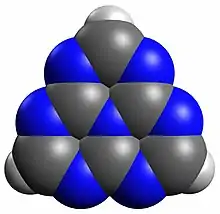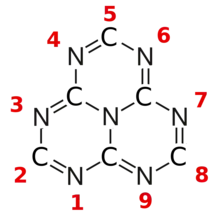Heptazine
Heptazine, or tri-s-triazine or cyamelurine, is a chemical compound with formula C
6N
7H
3, that consist of a planar triangular core group or three fused triazine rings, with three hydrogen atoms at the corners. It is a yellow, weakly fluorescent solid with melting point over 300 °C. It is soluble in organic solvents such as acetonitrile, but is decomposed by water in the presence of light.[1][2]
 | |
 | |
| Names | |
|---|---|
| Preferred IUPAC name
1,3,3a1,4,6,7,9-Heptaazaphenalene | |
Other names
| |
| Identifiers | |
3D model (JSmol) |
|
| 5529795 | |
| ChEBI | |
| ChemSpider | |
PubChem CID |
|
CompTox Dashboard (EPA) |
|
| |
| |
| Properties | |
| C6H3N7 | |
| Molar mass | 173.14 g/mol |
| Appearance | Yellow solid |
| insoluble | |
| Solubility | soluble in acetonitrile |
Except where otherwise noted, data are given for materials in their standard state (at 25 °C [77 °F], 100 kPa).
Infobox references | |
The name "heptazine" is also used for derivative compounds, which have the three hydrogens substituted by other functional groups. Heptazine oligomers and polymers were discovered in the 19th century but their study has long been hampered by their general insolubility. They are used as flame retardants. Heptazine derivatives have been the object of interest recently for potential applications in electronics materials, explosives, and more. The synthesis of heptazine proper was reported only in 1982.[3]
History
Berzelius discovered in 1815 that the ignition of mercuric thiocyanate Hg(SCN)
2 yielded, besides cinnabar HgS, carbon disulfide, and nitrogen, a yellow insoluble residue.[4] In the same year, Wöhler described the characteristic twisted yellow column that forms when the salt is ignited and burns (which is the popular "Pharaoh's serpent" school chemistry demo).[4] This foam has recently been found to consist of highly and randomly folded sheets of a material with composition close to C
3N
4. The sheets are very thin (less than 20 nm) and have been conjectured to consist of heptazine or tri-s-triazine cores linked at their corners by nitrogen atoms.[5][6]
In 1834 Liebig described the compounds that he named melamine, melam, and melon.[7] In the following years, Leopold Gmelin and Wilhelm Henneberg prepared novel salts that were eventually recognized as related to the compounds described by Liebig, and named melonates and cyamelurates.[8][9][10]
The structure of these compounds was elucidated only in 1937, by Linus Pauling and J. Holmes Sturdivant. They showed by X-ray crystallography that these compounds contain a core C
6N
7 of fused triazine rings, which they named "cyameluric nucleus".[10][11]
The synthesis of unsubstituted heptazine was reported only in 1982, by R. S. Hosmane and others from the group of N. Leonard.[3][1]
The structure of Liebig's melon eventually identified by T. Komatsu as consisting of linked heptazine units[12][11]
Structure and properties
According to Pauling and Sturdivant, the heptazine core is best described as a resonance equilibrium of 20 different structures:[10]





Each of the last three structures above has 5 other versions that differ by rotation and/or mirroring of the whole molecule. If one averages pairs of structures that are equivalent through mirroring, or triplets equivalent through 120 degree rotations, the first 2 and the last 18 reduce to the following schemas:

(neutral).

(zwitterionic).
Heptazine has a peculiar crystal structure, whose cell spans 16 molecules in asymmetric positions and orientations.[3][1]
Theoretical calculations indicate that, in heptazine and some of its derivatives, the lowest triplet state (T1) has higher energy (by about ≈ −0.25 eV) than the lowest excited singlet state (S1). Thus heptazine was claimed to be the first example of a stable closed-shell organic molecule violating Hund's rule.[2]
Derivatives and uses


The derivative with three amino substituents (2,5,8-triaminoheptazine) is called melem. Melem can be polymerized by condensation with loss of NH
3, so that the heptazine cores are linked through amine (NH) bridges. The oligomers and polymers thus obtained are called melon.
Melem and melon are effective flame retardant compounds. The compounds have in common that they melt or decompose at very high temperatures and that they are insoluble in any solvent. This makes characterization difficult.
The heptazine derivate with three hydroxyl substituents is called cyameluric acid.
The heptazine derivative with an azide substituent and two hydroxyl groups is called Linus Pauling's mystery molecule. It is the last molecule he drew on his chalkboard (preserved for posterity) before he died in 1994. Two theories attempt to lift the mystery. It is suggested that Pauling failed to solve the double helix structure of DNA before Watson and Crick because he viewed uracil as an amide and not as the tautomeric hydroxy compound. The other theory suggests that Pauling intended to use the compound as a potential spectroscopic label for binding to DNA. Nelson Leonard observed that Pauling "must have returned to the source of his original structural inspiration for a new application."[11]
The tri-azido derivatives are investigated for their use as high-energy-density materials (explosives).[13]
It is believed that one of the graphitic forms of the carbon nitride C3N4 is built up of linked heptazines. Heptazines could be a precursor molecule to the diamond-like beta carbon nitride.
References
- Manouchehr Shahbaz, Shigeyuki Urano, Pierre R. LeBreton, Mitchell A. Rossman, Ramachandra S. Hosmane, Nelson J. Leonard (1984), "Tri-s-triazine: synthesis, chemical behavior, and spectroscopic and theoretical probes of valence orbital structure". Journal of the American Chemical Society, volume 106, issue 10, pages 2805–2811. doi:10.1021/ja00322a014
- Johannes Ehrmaier, Emily J. Rabe, Sarah R. Pristash, Kathryn L. Corp, Cody W. Schlenker, Andrzej L. Sobolewski, and Wolfgang Domcke (2019): "Singlet–Triplet Inversion in Heptazine and in Polymeric Carbon Nitrides". Journal of Physical Chemistry, Section A, volume 123, issue 38, pages 8099-8108. doi:10.1021/acs.jpca.9b06215
- Ramachandra S. Hosmane, Mitchell A. Rossman, and Nelson J. Leonard (1982), "Synthesis and Structure of Tri-s-triazine" Journal of the American Chemical Society, vol. 104 issue 20, pp 5497–5499. doi:10.1021/ja00384a046
- H. Irving (1935) "An historical account of Pharaoh's Serpents". Science Progress, volume 30, issue 117, pages 62-66.
- Thomas S. Miller, Anita d'Aleo, Theo Suter, Abil E. Aliev, Andrea Sella, and Paul F. McMillan (2017): "Pharaoh's Serpents: New Insights into a Classic Carbon Nitride Material". Zeitschrift für anorganische und allgemeine Chemie (ZAAC) volume 643, issue 21, Pages 1572-1580. doi:10.1002/zaac.201700268
- Xinchen Wang, Kazuhiko Maeda, Arne Thomas, Kazuhiro Takanabe, Gang Xin, Johan M. Carlsson, Kazunari Domen, and Markus Antonietti (2009): "A metal-free polymeric photocatalyst for hydrogen production from water under visible light", Nature Materials volume 8, pages 76-80. doi:10.1038/nmat2317
- J. Liebig (1834): Annalen Pharmacie, 10, 1.
- L. Gmelin (1835): Annalen Pharmacie, 15, 252.
- W. Henneberg (1850): Annalen Chemie und Pharmacie, 73, 228.
- Linus Pauling and J. H. Sturdivant (1937): "The Structure of Cyameluric Acid, Hydromelonic Acid and Related Substances". Proceedings of the National Academy of Sciences, volume 23, issue 12, page 615–620. doi:10.1073/pnas.23.12.615
- Elizabeth K. Wilson (2004), "Old Molecule, New Chemistry. Long-mysterious heptazines are beginning to find use in making carbon nitride materials". Chemical & Engineering News, May 26, 2004. Online version accessed on 2009-06-30.
- Tamikuni Komatsu (2001): "The First Synthesis and Characterization of Cyameluric High Polymers". Macromolecular Chemistry and Physics, volume 202, issue 1, pages 19-25. doi:10.1002/1521-3935(20010101)202:1<19::AID-MACP19>3.0.CO;2-G
- Dale R. Miller, Dale C. Swenson, and Edward G. Gillan (2004): "Synthesis and Structure of 2,5,8-Triazido-s-Heptazine: An Energetic and Luminescent Precursor to Nitrogen-Rich Carbon Nitrides". Journal of the American Chemical Society, volume 126, issue 17, pages 5372-5373. doi:10.1021/ja048939y